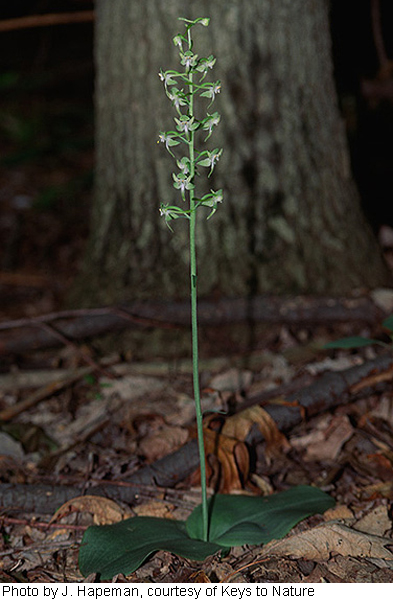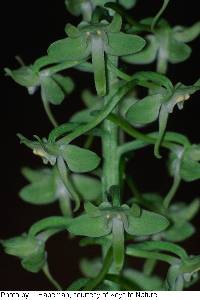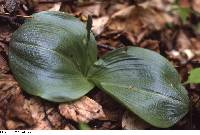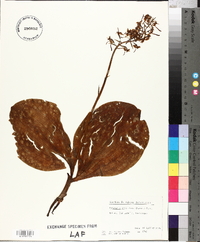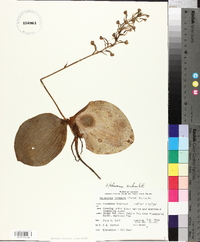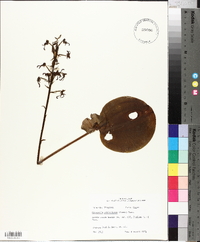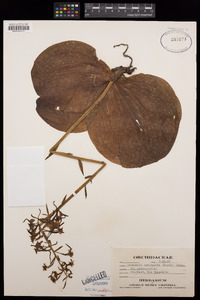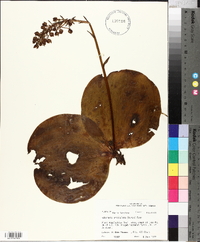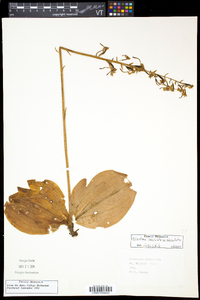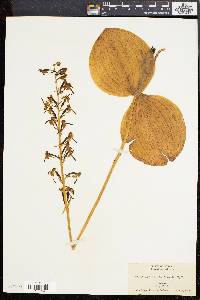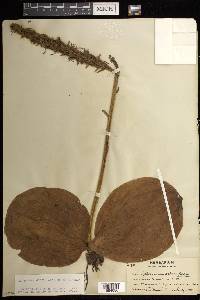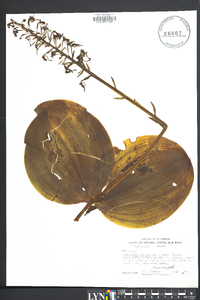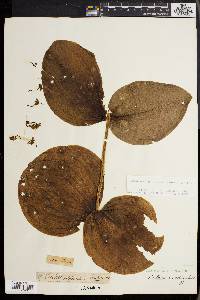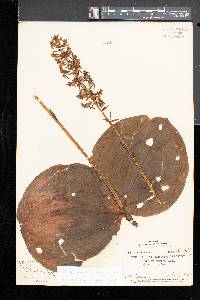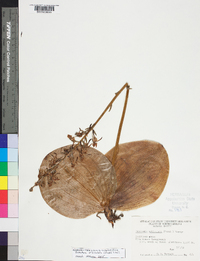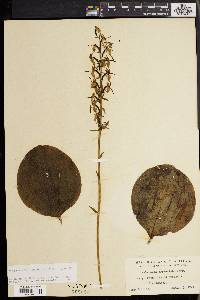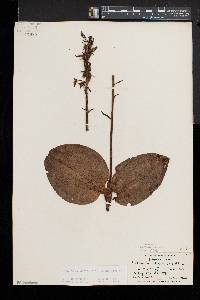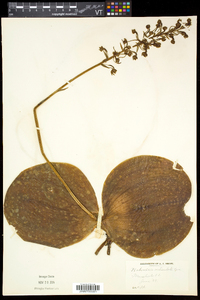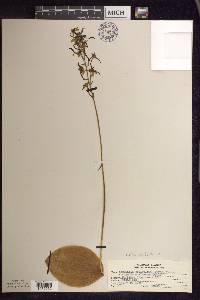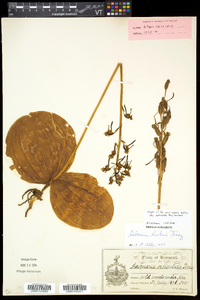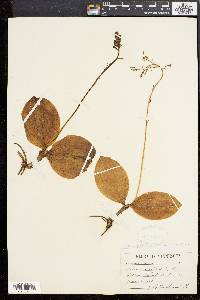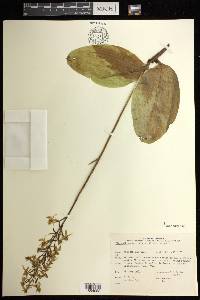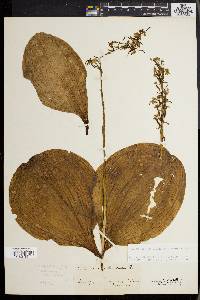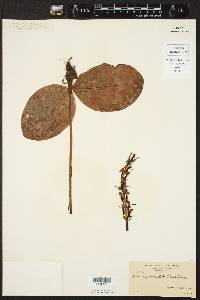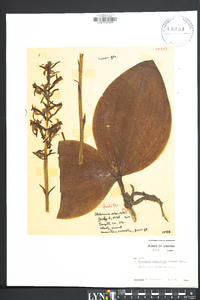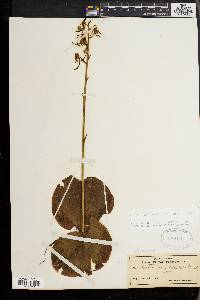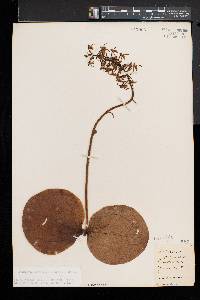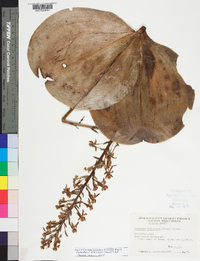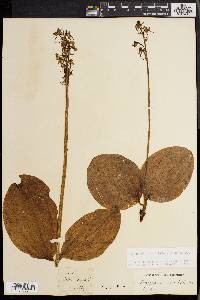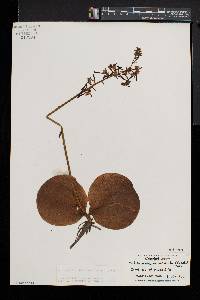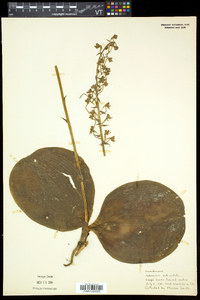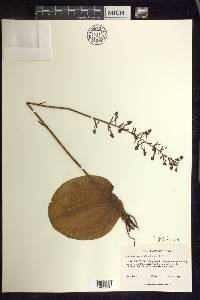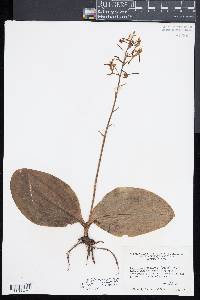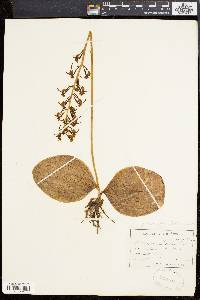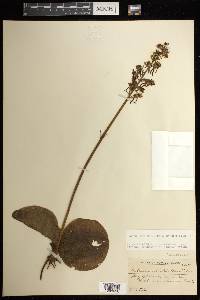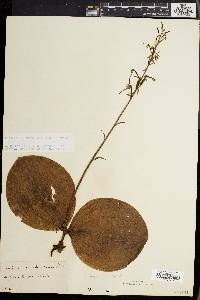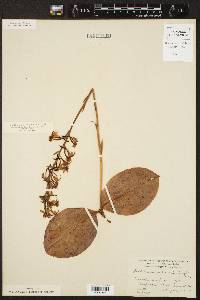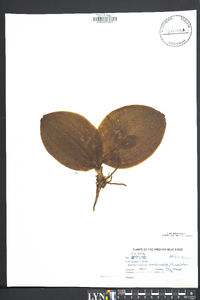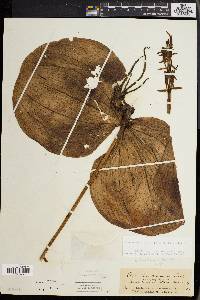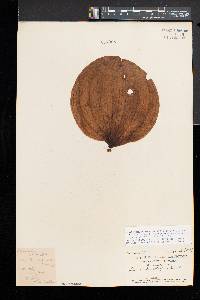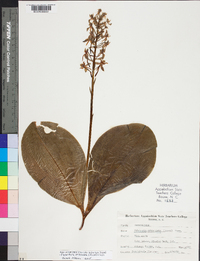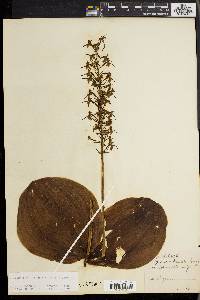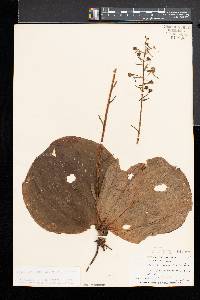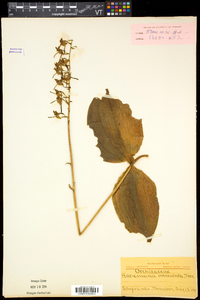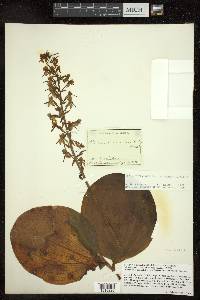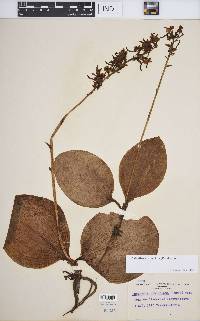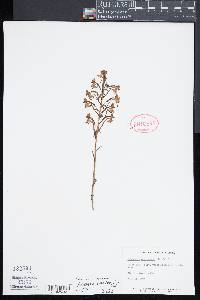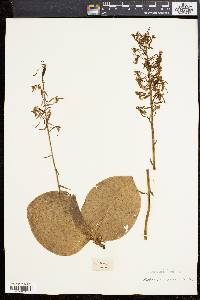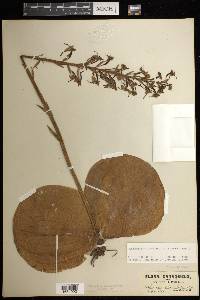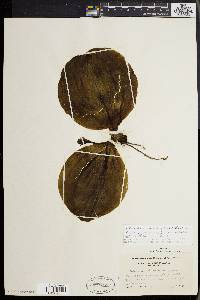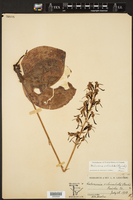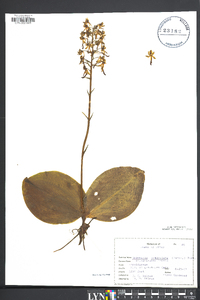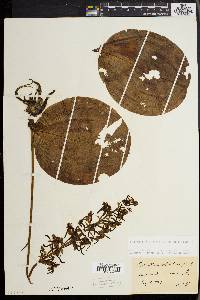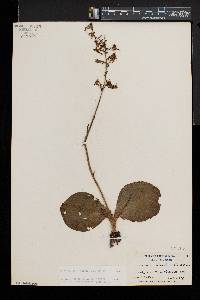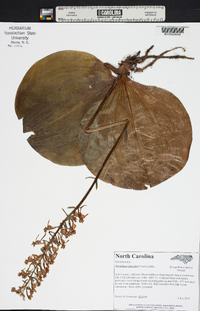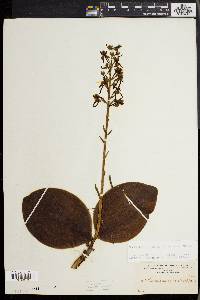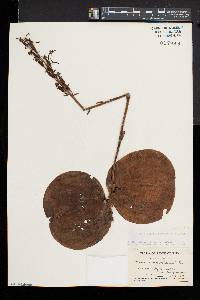Platanthera orbiculata
|
|
|
|
Family: Orchidaceae
Lesser Round-Leaf Orchid
[Habenaria orbiculata (Pursh) Torr.] |
Plants 17-62 cm. Leaves 2, in subequal basal pair lying on ground; bracts (very rarely, 0-)1-6, scattered along stem; blade broadly elliptic to orbiculate or oblate, 5-21 × 3-22 cm. Spikes lax to dense. Flowers resupinate, rather showy; calyx mostly greenish white; corolla mostly white; lateral sepals reflexed to somewhat spreading; petals lanceolate-falcate, margins entire; lip descending to somewhat reflexed, linear-oblong to linear-lanceolate, without basal thickening, 7-17 × 1-2.5 mm, margins entire; spur slenderly clavate, 14-27 mm; rostellum lobes directed strongly forward, wide-spreading, angular; pollinaria nearly straight, 3-4.5(-4.8, very rarely) mm; pollinia remaining enclosed in anther sacs; viscidia orbiculate; ovary slender to rather stout, mostly 10-26 mm. 2n = 42. Flowering Jun--Aug(--Sep). Mesic to wet coniferous and deciduous forest, fen forest; 0--1500 m; Alta., B.C., Man., N.B., Nfld. and Labr. (Nfld.), N.W.T., N.S., Ont., P.E.I., Que., Sask.; Alaska, Idaho, Ill., Ind., Maine, Md., Mass., Mich., Minn., Mont., Ohio, Oreg., Pa., N.H., N.J., N.Y., N.C., S. Dak., Tenn., Vt., Va., Wash., W.Va., Wis., Wyo. The key will permit determination of most specimens of Platanthera orbiculata and P. macrophylla. More precise discrimination of ambiguous specimens is possible by use of the formula from A. H. Reddoch and J. M. Reddoch (1993): spur length + (2 × pollinarium length), which for P. orbiculata is less than 38 and for P. macrophylla is equal to or greater than 38. Considerable variation in size and shape of leaves occurs, and although to some extent regional in nature, intergradation is complete; recognition of infraspecific taxa is unwarranted. A few collections from isolated areas on the Pacific Coast of Canada are noteworthy, however. Those are small, few-flowered plants with rather narrow leaves borne alternately or suboppositely toward the base of the stem, as in some Asiatic species. They are in some respects very similar to Platanthera freynii Kränzlin, an Asiatic species distinguished primarily by its abruptly narrowed petals, in contrast to the generally broader, but variable, petals in North American plants. These western plants warrant further study to establish their identity and to elucidate relationships between North American and Asiatic species.
Perennial herb 17 - 62 cm tall Stem: single, erect, green, somewhat angled, relatively slender, hairless, with only two basal leaves, but one to six lance-shaped bracts scattered below inflorescence. Leaves: two, basal, subopposite, stalkless, laying on ground, shiny-glossy and pale bluish green above, silvery below, non-toothed, hairless, 5 - 25 cm long, 3 - 22 cm wide, round-circular in large plants, and more oblong-elliptic in smaller plants. Inflorescence: a single, erect, terminal, stout, hairless, elongate, loose, spike-like cluster of five to twenty-five stalked flowers with each flower subtended by a short bract. The 0.8 - 1 cm long, 2 - 3 mm wide, linear to narrowly lance-shaped, pointed, non-toothed, hairless bracts are never longer than the flowers. Flowers: stalked, greenish white, sometimes with faint mauve shading, somewhat showy, small, hairless, bilaterally symmetric with spreading lateral sepals and petals, and center sepal above the narrow lip petal, which has base modified into a nectar spur. The reproductive parts of stamens, stigma and style are fused into a column above the 1 - 2.6 cm long inferior ovary. Sepals: three, petal-like, greenish white, hairless, non-toothed, over 5 mm long. The two egg-shaped to obtuse lateral sepals are reflexed to spreading, curved, and a little longer (up to 1.5 cm long) than the central, uppermost sepal, which is typically only to 1 cm long, more rounded, and erect, but arching over the lip petal and column. Fruit: many, stalked, rigidly erect (held parallel to inflorescence stalk), narrowly ellipsoid, hairless capsules above short remnant bracts. Roots: fleshy and thickened. Lateral petals: two, white to greenish white, spreading, reflexed to sides with tips curved upwards, 0.5 - 1.2 cm long, 2 - 4 mm wide, egg- to lance-shaped, hairless, and non-toothed. From the front, the lateral petals resemble horns to the sides of the rounded center sepal. Lip petal: one, central, lowermost, descending to somewhat recurved, white to greenish white, 0.7 - 2.4 cm long, 2 - 5 mm wide, linear oblong, non-toothed, and hairless. The base of the lip petal is modified into a backward pointed, long (1.4 - 2.7 cm), cylindric spur with a thickened tip like a slender club. Similar species: In our area, Platanthera orbiculata is most similar to P. hookeri, which usually blooms earlier, and differs morphologically by usually not having any bracts along the stem, the leaves are dull and even if laying on the ground the edges ascend slightly, the flowers are more greenish yellow to green, and the center sepal and lateral petals are close together and form a hood over the column and the upward curving lip, which when viewed from the side the flower is a somewhat "c-shape" and looks like a pair of ice tongs, or when viewed from the front looks like an open-mouthed snake baring its fangs. A more northern species, P. obtusata, also appears somewhat similar but it is typically under 25 cm tall, has green flowers, and only has one basal leaf, which is fairly erect or ascending and widest above the middle. Incredibly similar is another northern species, P. macrophylla, but the spur is longer (usually greater than 2.8 cm long). Flowering: late June to August Habitat and ecology: Very rare, generally in mesic to wet coniferous and deciduous forests, but in our area known from mesic lakeshore ravines and fens. Occurence in the Chicago region: native Notes: There is quite a bit of variation in the size and shape of leaves for P. orbiculata, but most taxonomists do not recognize any need for infraspecific designations. Etymology: Platanthera comes from the Greek words platys, meaning flat or broad, and anthera, meaning anther, which refers to the wide anther of the genus. Orbiculata means circular, which refers to the nearly circular shape of the leaves. Author: The Field Museum Scape arising from fleshy roots, 3-6 dm, with a few narrow bracts; lvs 2, basal, prostrate, 10-15(-25) cm, broadly elliptic to rotund, seldom narrower; infl loose, 5-20 נ4-5 cm; fls white or greenish-white, on pedicels 5-10 mm; lip oblong-linear, directed downward, 10-20(-25) mm; sep and lateral pet widely spreading, the pet directed obliquely upward; spur 15-25(-45) mm, usually directed transversely and somewhat dilated distally; tips of the pollen-sacs projecting in front of the nectary and widely spreading; 2n=42. Moist woods; Lab. to Alas., s. to Pa., Ind., Minn., and Oreg., and in the mts. to N.C. and Tenn. July, Aug. (Lysias o.; Platanthera o.) Robust plants with large lvs and large fls with a notably long spur have been distinguished as var. macrophylla (Goldie) B. Boivin. (H. macrophylla) Gleason, Henry A. & Cronquist, Arthur J. 1991. Manual of vascular plants of northeastern United States and adjacent Canada. lxxv + 910 pp. ©The New York Botanical Garden. All rights reserved. Used by permission. From Flora of Indiana (1940) by Charles C. Deam This is one of our rarest orchids. I have found it twice. Van Gorder found it in Noble County and I have his specimen. It grows in very rich, sandy soil with sugar maple and beech. …… Indiana Coefficient of Conservatism: C = 10 Wetland Indicator Status: FAC |

